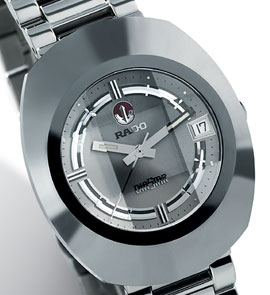

rado
Historique de la maison d'horlogerie Rado
1917: Fondation à Longeau (Lengnau) de la fabrique de mouvements d'horlogerie Schlup & Co. dont Rado naîtra ultérieurement.
En 1957, après quatre décennies en tant que fournisseur de mouvements horlogers, la firme d'alors, Schlup & Co., lançait sa première collection de montres sous le nom de marque 'Rado'. Au bout de cinq ans seulement, la 'DiaStar' ovale inrayable était lancée et le premier jalon d'une histoire à succès extraordinaire était ainsi posé.
Tout a commencé lorsque Marc Lederrey, le chef designer Rado d'alors, a exposé une idée totalement nouvelle. Il trouvait irritant que les montres en or et en acier – qui certes étaient belles en étant neuves – présentaient des traces de rayures, souvent après quelques jours déjà, et devaient être constamment repolies.
A cette époque, le métal dur issu des carbures de tungstène et de titane était déjà connu comme étant un matériau extrêmement résistant employé uniquement dans la fabrication d'outils et d'outillage spécial hautement technologique. "Utiliser ce matériau pour faire une montre, ce serait super!" suggéra Lederrey. Et le Dr Paul Lüthi, qui était alors le chef de Rado, donna son feu vert pour le développement. Le résultat: la première montre inrayable du monde!
Depuis la fondation de l'entreprise, Rado mise sur des matériaux du futur tels que le métal dur, le verre saphir, la céramique high-tech, le lanthane high-tech et le diamant high-tech.
Tandis que d'autres fabricants d'horlogerie utilisent toujours des matières traditionnelles comme l'or, le laiton ou l'acier, Rado ne contente pas de puiser dans les matériaux existants, elle se lance elle-même dans la recherche pour produire des matériaux novateurs et toujours plus durs. Cela dans le but de concevoir une combinaison design/matériau en harmonie parfaite avec la double fonction de la montre: bijou moderne et instrument de mesure du temps fonctionnel.
1917: Foundation of the watch movement company Schlup & Co. in Lengnau (Canton of Berne, Switzerland) by the Schlup brothers. This supplier to the watch industry should later become Rado Watch Co. Ltd.
In 1957, after four decades as a supplier of watch movements, the then Schlup & Co. launched its first watch collection under the brand name 'Rado'.
Just five years later, the foundation stone for an exceptional success story was laid with the oval, scratchproof 'DiaStar'. It all began when the Rado head designer at the time, Marc Lederrey, came up with a completely new idea. It annoyed him that gold and steel watches might be beautiful to start with but often showed scratch marks after only a few days and had to be continually re-polished.

At this time, types of hard metal made from tungsten- and titanium-carbides were only known as extremely resistant materials used in the manufacture of tools and specialized high-tech instruments. "It would really be something to make a watch from such a material", Lederrey suggested. And Dr Paul Lüthi, then head of Rado, gave the go-ahead for development. The result: the world's first scratchproof watch!
Since the foundation of the company, Rado has thus purposefully chosen materials of the future such as hardmetal, sapphire crystal, high-tech ceramics, high-tech lanthanum or high-tech diamond. While other brands use conventional materials like gold, brass or steel, Rado is not satisfied with already existing materials but develops and itself produces new, even harder materials. And this is always in the endeavor to develop design/material combinations that unite in perfect harmony the double functions of the watch as a modern piece of jewelry and a functional timepiece.